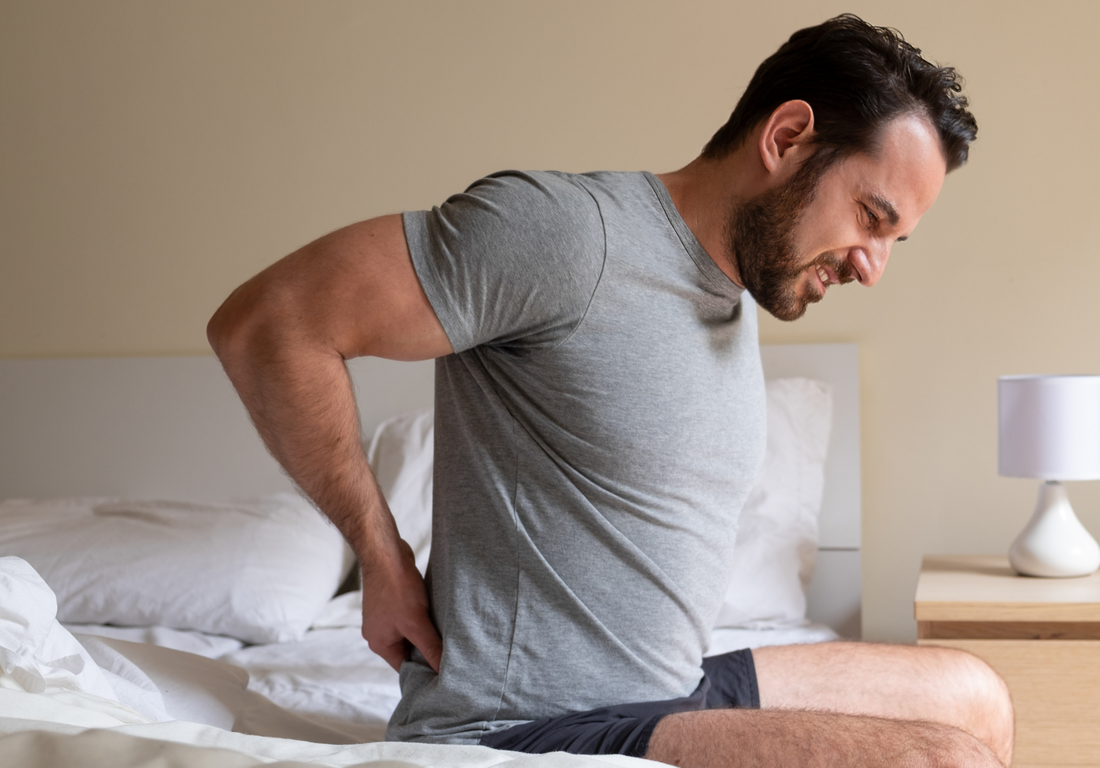More than 50 million adults experience chronic pain in the US. Most chronic pain patients report that their pain fluctuates throughout the day and some research suggests that pain worsens at night. We’ll discuss some causes behind this phenomenon and whether morning and evening pain can be attributed to poor sleeping posture. We will also discuss the best sleeping position for lower back pain, how to sleep with lower back pain, and what causes neck pain after sleeping.

What is Sleeping Posture?
Sleeping posture refers to the position of the body during sleep. This includes spinal alignment, neck positioning, leg positioning, hip positioning, and whether an individual is sleeping on their back, front or side. Most medical professionals and physios would argue that a good sleeping posture involves adopting a position that supports the natural curvature of the spine, minimizes stress on the back and neck, and facilitates relaxed muscles and joints. While there are some key practices for improving sleep, at FP we believe there is no best sleeping position for lower back pain and that improving sleeping posture won’t actually make a significant difference in your chronic pain symptoms.

What Causes Chronic Pain and How to Resolve it
At Functional Patterns, we argue that chronic pain from waking up or while sleeping, is actually caused by dysfunctional patterns of movement. When an individual repeatedly performs asymmetrical motions, their body will develop myofascial imbalances that lead to structural asymmetries. These structural asymmetries affect a wide range of body parts from joints to ligaments and even bone shape. That is why it important not just to perform physical activities, but also how you do them counts towards how your physical structure adapts.
We help our clients eliminate chronic pain by improving their movement patterns which makes their structure more adaptable to various environmental stimuli to better prevent pain. Through improving movement we address the most fundamental cause behind things like lower back pain, neck pain, and shoulder pain. In doing so, clients discover a newfound sense of calm, relaxation, and stability in their bodies which translates to improved sleep and no pain while sleeping. Most importantly, we achieve this without addressing sleeping posture at all. Individuals who resolve the root cause of their pain rarely report neck pain after sleeping or ask about a “best sleeping position for lower back pain”, or “how to sleep with lower back pain”. To summarize this paragraph, if you move athletically and without serious compensations or imbalances, you are unlikely to experience pain in general and much more likely to get an excellent night's sleep every night.
Important Tips for Quality Sleep

As stated by Functional Patterns founder, Naudi Aguilar, when it comes to sleeping posture or sleeping positions, there isn't an ideal one if you haven't addressed your standing posture and gait cycle/movement. After you have started addressing these aspects of your physical structure, then Naudi does have some recommended tips that you can review in the video. With that being said, below are some basic but key sleep habits that everybody should follow.
- Finish your last meal at least 3-4 hours before bed to help with better digestion and allowing the body to reach a rested state before falling asleep.
- Limit exposure to screens and stimulating entertainment that might induce stress before you ready yourself for sleep. Certain shows, movies, or even books can release adrenaline, putting your body in a fight-or-flight state even though there is no real danger.
- Spend some time in red light. If it's available to you, sit outside next to a fire pit, light a candle, or relax in front of an infrared light device.
- Invest in an alarm clock, and turn both your phone and router off at night to minimize EMF exposure, as well as the temptation for late night doom scrolling.
- Invest in a sleep mask or curtains that block out light so that you aren't disturbed by light pollution outside your bedroom window.
- Other options:
- Tape your mouth
- Taping your mouth encourages nose breathing which has been shown to have numerous health benefits.
- Reduces sleep apnea and snoring intensity
- Reduced jaw clenching and grinding
- Wear Ear Plugs
- A lot of us either have roommates, don't have sound proof walls, or live on private properties. Eliminate sound pollution and other audible disturbances with ear plugs.

Conclusion
Whenever a client asks us about something like how to sleep with lower back pain, we always start by improving their movement and thus improving their structure. Athletic, efficient movement, translates to improved posture and improved sleep posture. We recommend everyone follow the protocols listed above to further supplement their sleep and reduce pain while sleeping.
For additional guidance on optimizing sleep and rest for addressing pain, please see the resources below:







